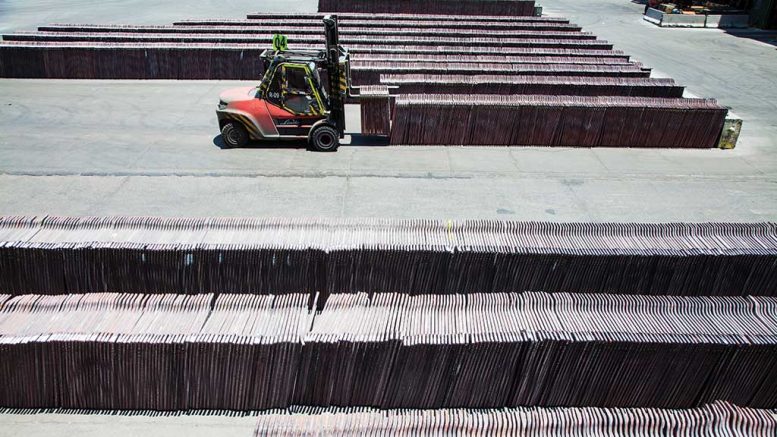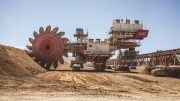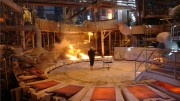The following is an edited release from the International Copper Study Group (ICSG) showing world copper supply and demand for 2017. For more detailed information, visit www.icsg.org.
World copper mine production is estimated to have declined 2% in 2017, with concentrate production declining 1.6% and solvent extraction-electrowinning (SX-EW), 3%.
Mine production fell 4% year-over-year in the first half of 2017 due to supply constraints, but the situation improved in the second half, with output staying flat year-over-year, but increasing 10%, compared to first-half 2017.
The reduction in world mine production mainly owed to:
• A 1% decline in Chile, the world’s biggest copper-mine-producing country, which was negatively affected by the strike at the Escondida mine in the first part of the year and lower output from Codelco mines;
• Reductions in concentrate production in Argentina, Canada and Mongolia of 59%, 14% and 14%, which mainly came from lower grades in planned mine sequencing and Argentina’s Alumbrera mine approaching end-of-life;
• A 12.5% decrease in Indonesian concentrate production as output was constrained by a temporary ban on concentrate exports that started in January and ended in April.
• A 12% fall in production in the U.S., mainly due to lower ore grades, lower mining rates and unfavourable weather conditions at the beginning of the year.
However, these reductions in output were partly offset by 30% and 4% increases in Kazakhstan and Peruvian mine production, with both countries benefitting from new and expanded capacity that was not fully available in 2016.
Brazil, Mexico, Myanmar, Spain and Sweden also contributed to world growth.
On a regional basis, mine production declined 2% in the Americas; in Asia, 4%; and in Oceania, 5%; while increasing in Africa and Europe (including Russia) by 2.5% and 2%.
World refined production increased an estimated 0.6% in 2017, with primary production (electrolytic and electrowinning) declining 0.15% and secondary production (from scrap) increasing 4.5%.
More scrap helped world secondary refined production increase, notably in China.
The main contributor to growth in world refined production was China (a 5% increase), followed by India (6%) and some EU countries, where output recovered after maintenance shutdowns in 2016.
However, overall growth was offset by a 7% decline in Chile, the second-largest refined copper producer, where both primary electrolytic refined production and electrowinning production fell.
Production also dropped in the third- and fourth-ranked refined copper producers — namely Japan (-4%) and the U.S. (-12%) — mainly due to maintenance shutdowns at several plants.
On a regional basis, refined output increased an estimated 1.5% in Africa; 3.5% in Asia; and 3.7% Europe, while declining 7.5% in the Americas and 15% in Oceania.
World apparent refined usage saw a modest 0.7% increase in 2017.
Improved scrap supply constrained world refined copper usage growth globally in 2017.
Preliminary data indicates that world ex-China usage increased 0.5%, while Chinese apparent usage (representing almost half of world refined usage) increased 0.9%.
Chinese apparent usage (excluding changes in unreported stocks) increased 0.9%, as although refined copper production increased 5%, net imports of refined copper declined 9.5%.
Among other major copper-using countries, usage increased in India and Japan, but declined in the U.S., Germany and South Korea.
Copper balance
World refined copper balance for 2017 indicates a 163,000-tonne deficit (including revisions to data previously presented). This mainly owes to an almost stagnant situation in world refined copper supply.
In developing its global market balance, ICSG uses an apparent demand calculation for China that does not take into account changes in unreported stocks (i.e., State Reserve Bureau producer, consumer, merchant/trader, bonded). To facilitate global market analysis, however, another item — Refined World Balance Adjusted for Chinese Bonded Stock Changes — adjusts the world refined copper balance based on an average estimate of changes in unreported inventories provided by three consultants with expertise in China’s copper market.
In 2017, the world refined copper balance adjusted for changes in Chinese bonded stocks indicates a deficit of 135,000 tonnes.
Copper prices and stocks
Based on the average of stock estimates provided by independent consultants, China’s bonded stocks increased 30,000 tonnes in 2017 from the year-end 2016 level. Bonded stocks increased 15,000 tonnes in 2016.
As of the end of February, copper stocks held at the major metal exchanges (i.e., London Metal Exchange [LME], COMEX and Shanghai Futures Exchange [SHFE]) totalled 755,847 tonnes a 213,318-tonne increase (39%) from stocks held at the end of December 2017. Compared with the December 2017 levels, stocks were up at the LME (63%), SHFE (45%) and COMEX (9%).
The average LME cash price for February was US$7,001.80 per tonne, up from the January average of US$7,080.30 per tonne.
The 2018 high and low copper prices through the end of February were US$7,202.50 per tonne (on Jan. 4) and US$6,755 per tonne (on Feb. 9), and the yearly average was US$7,042.92 per tonne (14% above 2017 annual average).






Be the first to comment on "Facts ‘n’ Figures: Copper mine output slumps 2% in 2017"